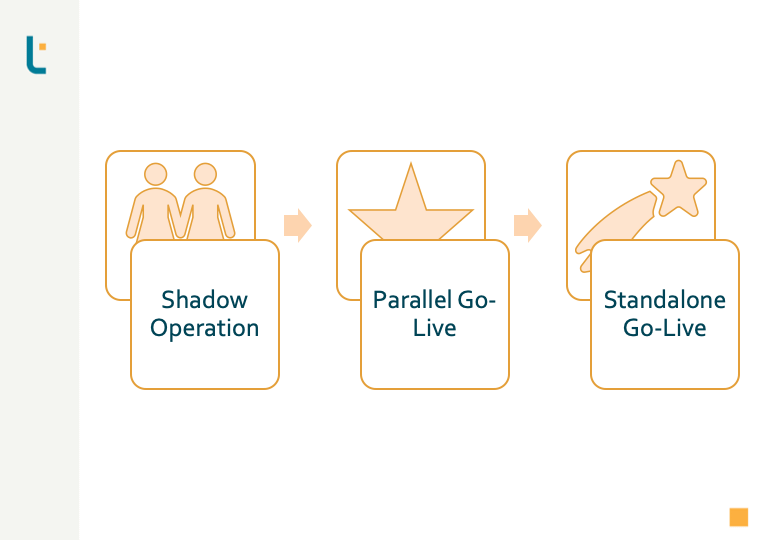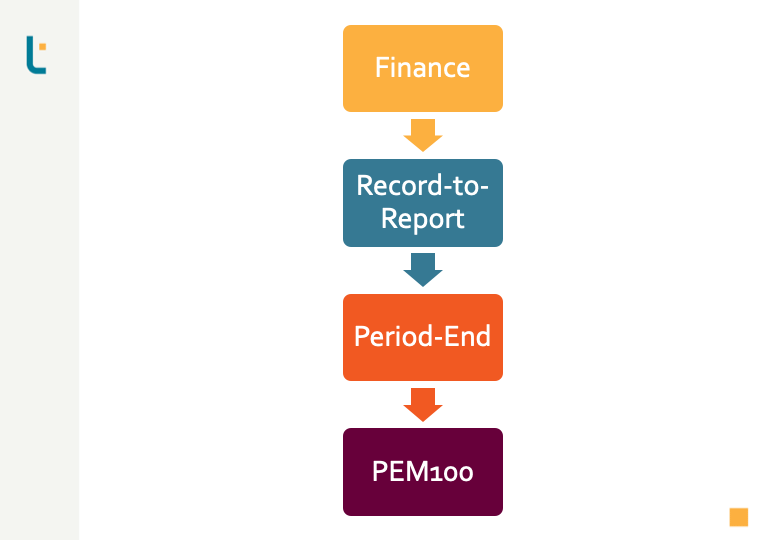Deployment for Finance Transformation: Ensuring a Successful Go-Live

AUTHOR: JENNIFER LOUGHRIDGE
PRINCIPAL CONSULTANT
Jennifer is a Senior Executive Finance professional with 22+ years of global experience. She specialises in Finance Transformation, ESG and Continuous Improvement, with particular expertise in Strategy, Performance Management, Business Partnering, Commercial Decision-Making, Corporate Governance and Valuation.
This post will focus on the eighth of the nine steps: Deployment for Transformation. First, we will finalise the design, prepare for deployment, and then deploy the Finance Transformation.
Our last post in this nine-part series looked at Prepare for Delivery. We looked at project and change management. We also covered the first three StageGates in the Project Delivery Framework, focusing on what is particularly pertinent to Finance Transformation.
Finalising Design and Preparing for Successful and Sustainable Deployment for Transformation
If you have been following the Loughridge Transformations method, you will, by now, have covered the following steps:
-
Strategy: How to Supercharge Finance Transformation
The Loughridge Transformations approach to strategy.
-
Finance Functional Fit: The Most Critical Scope Definition You Need
The Loughridge Transformations method of determining the Finance Functional Fit – the most critical scope definition you need.
-
Baseline Definition – A Reliable Assessment Model for the Finance Function
Learn how Loughridge Transformations effectively evaluates baseline data to achieve successful Finance Transformation.
-
Define the Future – Target Setting & Benchmarking
The Loughridge Transformations structured approach to working with benchmarks and establishing targets for Finance Transformation.
-
Choose The Lever for Successful Finance Transformation
The Loughridge Transformations method of Finance Transformation: Choose The Lever – discover the tools and strategies that will set you on the path to achieving targets.
-
Finance Transformation: Understand The Context to Secure Excellence
Examining the importance of understanding what’s happening around you and identifying what could impact your Finance Transformation.
-
Power Up the Design and Ensure Robust Finance Transformation
The Loughridge Transformations approach to delivering the design phase of projects.
We can finalise the design and start the deployment phases of Finance Transformation at this stage.
Transitioning to Deployment for Transformation
Our last post concluded our practical example by obtaining StageGate Three (Design) approval. Now, we are ready to proceed to StageGate Four (Prepare to Deploy) and StageGate Five (Deploy).
Together, these StageGates cover the primary high-level phases of deployment for transformation:

Prepare to Deploy
After passing StageGate Three, the fundamental or “global” design will already be in place. In “Prepare to Deploy,” attention shifts to “local” legal or fiscal requirements. This phase is crucial as it’s where we apply the design standards to specific legal entities or business units, setting the stage for the actual deployment.
Most of the “Prepare to Deploy” deliverables concern the remaining parts of the organisational design and the associated change management requirements.
Standard Organisation Model
At the previous StageGate, you will already have completed the following:
- Define Process Roles
- Determine Location
- Map Roles to Jobs
- Design Reporting Structures
- Define Competence & Behaviour Requirements for Jobs
The focus now is on completing and finalising the rest of the Standard Operating/Organisation Model (SOM).
Final Job Mapping
You can complete the final mapping using the Standard Mapping of Roles to Jobs delivered at StageGate Three.
To explain this final mapping, we will use Manual Journal Entries as an example.
You will have mapped each activity to a role with defined competence requirements. Given the volume of roles covered in an extensive transformation programme, it is wise to maintain a naming convention. For example, RtR010 could be a role within Record to Report, preparing Manual Journal Entries.
In this Manual Journal Entries example, we must also consider the Segregation of Duties. Therefore, Approving Manual Journal Entries is usually a separate role to maintain the segregation.
These roles combine to form jobs. Therefore, each job will have attributes and competencies – both technical and behavioural – driven by the roles underpinning it. Again, it is wise to maintain a naming convention; for example, the closing team manager’s job is PEM100 (PEM: Period End Manager).
Last but not least, the jobs fit the standard reporting structure and should be validated for the specific business unit or legal entity. To conclude the example, PEM100 will be in the Period End Team under Record to Report within Finance.

Over and above the distinct advantage of a clearly defined organisation that includes accountabilities and responsibilities, another benefit within the roles-jobs-structure definition is the possibility of leveraging ERP functionality. It is the case that most ERPs cater for role definitions, and as such, you can tailor the system access for each role and establish a Segregation of Duties matrix.
Work Instructions & Training
If your SG3 deliverable on work instructions was detailed only to Level 5, now is the time to complete it to Level 7.
High-quality work instructions are essential for a successful deployment. They are living documents that the owner or user should regularly update to address, for example, error resolutions.
Process experts and owners should also sign off on the work instructions to ensure accuracy and quality.
At this point, you should also be able to develop any supporting training material. This training typically goes beyond the mechanics of the process and is vital for the user to understand the end-to-end process.
Job Evaluation

This step is relevant only when applying the design to a specific business unit or legal entity. It starts with determining the applicability of any given process and then sizing the jobs within that particular environment. This applicability and sizing exercise, together with all the standard design elements, allows you to finalise the application of the standard reporting structures and evaluate the job levels.
Change Management and Employee Relations
In many legal frameworks, specific employee relations activities are mandatory when work is off-shored. However, even in locations where requirements are few, organisations often have values and approaches that they want to uphold during the deployment of organisational transformation, so it is essential to recognise employee/industrial relations.
Given the scale of change involved, it is critical to have a robust change management plan that appropriately recognises the change’s extent, nature and depth.
Checkpoint: Questions to Ask Before Moving On
- Do we understand what we are starting, and is the initial structure in place to move forward?
- Are we ready to prepare the organisation for the new operating model?
- Are we ready to start operating with the new model?
- Is the new operating model working as intended? (applies both in SG4 and SG5)
Deploy and Stabilise (SG5)
In the final SG5: “deploy and stabilise”, the key deliverables are:
- Shadow Operation
- Parallel & Standalone Go-Lives
Shadow Operation
The actual handover of processes now takes place between on-shore and off-shore locations. This activity is also known as work shadowing. Two primary drivers of the duration of this step are the complexity of the process and the degree of standardisation. A more complicated process may require a more extended work shadowing phase. Standardisation, however, has an even more significant impact on the duration. The higher the level of standardisation, the less time will be needed in this phase.
Parallel Go-Live
Once the handover and training period are complete, the decision to go live or delay is made. Unless you face significant issues or have serious concerns, we recommend going live via Parallel Go-Live. In This method, the off-shore team performs the process while being closely monitored and assisted where required by the on-shore organisation.
In almost every handover situation, something that has not been adequately covered or documented will arise. The parallel go-live period is intended for the off-shore process operator to demonstrate how well they perform the process in a “safe zone” where help is available. Again, the length of the parallel go-live period varies, but one to two months is not uncommon.
Standalone Go-Live
Once the parallel go-live period is complete and both off-shore and on-shore teams are satisfied with the performance quality, the off-shore team takes over responsibility for the process. Operations fully commence in the new working environment.
Final Thoughts on Deployment for Transformation
A final note on this example: You may have noticed that we have covered more detail in the other StageGates (1-4) than in the final StageGate 5. That is no coincidence. The more effort you put into each StageGate, especially the SG4 preparation stage, the smoother the actual deployment.
Almost every large-scale project will face time pressure, and it is tempting to save time at the earlier StageGates. However, this approach will likely lead to a lengthy and potentially messy SG5 and go-live situation. Decision-makers are responsible for following through on previous StageGates and ensuring that the project team executes the appropriate work during the correct phase.
Interested in More Finance Transformation?
Our next post will focus on the ninth step: Sustaining the Change. Discover how to maintain momentum after implementing transformative changes, ensuring they become deeply embedded in your organisation. Read on to explore strategies and insights that will keep your finance team thriving in a rapidly evolving landscape.
Has our blog piqued your interest, and are you curious to learn more? Contact one of our expert consultants to explore how we can support you on this journey.
Have you missed some of the other posts in this series? Find them here:
-
Nine Steps to Finance Transformation
An introduction to a series of blog posts on nine scalable and modular steps to deliver successful and sustainable Finance Transformation.
-
Strategy: How to Supercharge Finance Transformation
The Loughridge Transformations approach to strategy.
-
Finance Functional Fit: The Most Critical Scope Definition You Need
The Loughridge Transformations method of determining the Finance Functional Fit – the most critical scope definition you need.
-
Baseline Definition – A Reliable Assessment Model for the Finance Function
Learn how Loughridge Transformations effectively evaluates baseline data to achieve successful Finance Transformation.
-
Define the Future – Target Setting & Benchmarking
The Loughridge Transformations structured approach to working with benchmarks and establishing targets for Finance Transformation.
-
Choose The Lever for Successful Finance Transformation
The Loughridge Transformations method of Finance Transformation: Choose The Lever – discover the tools and strategies that will set you on the path to achieving targets.
-
Finance Transformation: Understand The Context to Secure Excellence
Examining the importance of understanding what’s happening around you and identifying what could impact your Finance Transformation.
-
Power Up the Design and Ensure Robust Finance Transformation
The Loughridge Transformations approach to delivering the design phase of projects.
-
Deployment for Finance Transformation: Ensuring a Successful Go-Live
The Loughridge Transformations approach to the implementation phase of projects.
-
Sustain the Change: Finance Transformation to Last
The Loughridge Transformations way to actively reinforce the new practices and monitor their impact to pave the way to drive your Finance Transformation forward
-
Reviewing the Nine Steps to Finance Transformation
A summary of the series of blog posts on nine scalable and modular steps to deliver successful and sustainable Finance Transformation.
Alternatively, take a look at our most popular blog posts:
Or are you looking for something else? Here’s what we have been blogging about recently:
Agile Analytics Associates Automation Behaviours Building Trust Business-Partnering CFO Remit Change Management Coaching Collaboration Continuous Improvement Control Design Corporate Governance Data Deployment Design Principles Digital ERP ESG Finance Function Finance Transformation Implementation Migration Off-Shoring Organisation Organisation Design Process Process Design Process Performance Productivity Programme Management Office Project Management Readiness Risk & Controls Season's Greetings Skills sponsorship Standard Organisational Model Strategy Systems Systems Design Technology Transformation Virtual Working
